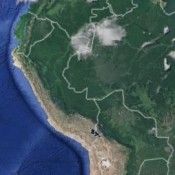Fifteen Years Of Warnings Were Ignored Before Recent Ash¡ninka Assassinations
Last week’s assassination of Peruvian indigenous leader Edwin Chota and three other indigenous leaders took much of the world by surprise, but Ash¡ninka leaders and human rights campaigners active along the Peru/Brazil border had been warning of the danger that illegal loggers posed since 1999.

11 September 2014 | Following the murder of indigenous leaders Edwin Chota Valera, Quinticima Leoncio Melendez , Jorge Rios Perez and Francisco Pinedo along the Peru/Brazil border, representatives from several organizations published a “Border Manifesto documenting 15 years of threats and ignored warnings. The manifesto is available for download (right), and we have provided a rough translation here:
- Beginning in 1999, the Ash¡ninka indigenous people living in the village of Apiwtxa in Brazil along the border with Peru have been warning state and federal authorities of Peruvians illegally logging timber in their territory and the environmental, social and cultural consequences that come from their actions. Citizens of Apiwtxa, on the Brazilian side of the border, have expressed particular concern for logging occurring in the indigenous territory of Land Kampa do Rio Ammonia and the Serra do Divisor National Park.
- Since 2002, Apiwtxa’s sister village of Saweto, on the Peruvian side of the border, has appealed to Peruvian officials on the basis of international laws that grant indigenous peoples the title to their ancestral land. They argue the government should lead a process of demarcation that gives them a legal title to their territory. But the Ash¡ninka peoples’ demands continue to be spurred as the cost of property titles are high and the political motivations of those working inside the office varies.
- In 2005, meetings sponsored by the Cross Border Working Group (Grupo de Trabalho Transfronteiri GTT) began occurring both in Acre, Brazil and in Peru’s Ucayali region. The meetings evaluate programs and monitor development of ongoing plans and strategies. GTT also monitors Peru’s forest concessions and the predominantly negative impact they have on indigenous lands.
- Indigenous organizations continued to form and hold meetings. Both Brazil’s and Peru’s Ashí¡ninka communities are communicating with each other. They discuss their shared problems and information and exchange successful strategies that resulted in better land management and protection of their territory.
- In 2011, the Ash¡ninka communities mobilized the Brazilian Institute for the Environment and Renewable Resources (Instituto Brasileiro de Meio Ambiente e Recursos Renov¡veis IBAMA) and the Chico Mendes Institute of Biodiversity (Instituto Chico Mendes da Biodiversidade ICMBio) to help them in securing the border. Several others, including the National Indian Foundation (Fundao Nacional do ndio FUNAI) and Operation Acai, which was a partnership with the federal police, were used as well. They all served a purpose in organizing the communities into one unit aimed at protecting their territory. They uncovered much illicit behavior- illegal logging and bulldozing along Brazil’s border were some of their discoveries.
- The groups compiled data from several sources including institutions like IBAMA but also the University of Richmond in Virginia, the Instituto del Bien Comºn (IBC) and the Secretaria de Estado de Meio Ambiente do Acre (SEMA). The information compiled resulted in a publication of history on the conflicts of the Brazil/Peru border.
- In 2012, the Cmara T©cnica de Desenvolvimento Sustent¡vel (CTDs), a space for debate and discussion between civil society and government, reported on uncontrolled drug and timber trafficking happening along the border as well as the swell of illegal Peruvian immigrants in Marechal Thaumaturgo-a municipality in western Acre.
- In June 2013, based on the data collected, Saweto leaders met with the Ministry of Foreign Affairs of Peru. The Saweto leaders presented the importance of titling their territory for environmental protection.
- Despite all these attempts illegal activities grew in this border region. There were some enforcement efforts but they failed to prevent forest concessions in Peru and an invasion of loggers. The lack of validity regarding the Ash¡ninka’s right to the forests left them all but powerless to stop the continued onslaught.
- The threats became so extensive, the plight of the Ash¡ninka people received international attention. National Geographic published an article on the Ash¡ninka peoples’ struggles to protect the forest from ongoing illegal logging.
Considerations
- The murder of the four men directly endangers Saweto and the other Ash¡ninka communities in the Acre-Ucayali region.
- Participation and cooperation of all the indigenous populations is needed. However, the tribe cannot assume the control and surveillance responsibilities necessary to prevent illegal activities and the ongoing violence.
- Titling is crucial for environmental protection and the Ash¡ninka people urge the governments to start the process. It’s complex. A forest concession that overlaps with Indian territory needs to be resized. The responsibility to adjust the forest concession and approve a legal title falls on the regional government, the Ministry of Agriculture and Irrigation and the Forest Service.
- Conservation and monitoring activities will fall to the indigenous communities residing on both sides of the border. Cooperation between them-particularly between Saweto and Apiwtxa resulting in bi-national policies is important.
Recommendations
- The manifesto recommends the installation of proper infrastructure along the border that will help to prevent illegal activity.
- There should be a permanent forum between Brazil and Peru’s authorities regarding illegal activities along the border.
- Establishment of cooperation between the two borders where the countries coordinate their strategies and implement plans together.
- Establishment of a monitoring system that is based on input from all stakeholders-indigenous communities, Brazilian and Peruvian authorities.
- Titling the land so it legally belongs to the Ash¡ninka is required for sustainable land management and effective environmental protection.
- Punishment for the instigators and perpetrators of the barbaric killing of the four Ash¡ninka leaders.
Please see our Reprint Guidelines for details on republishing our articles.

